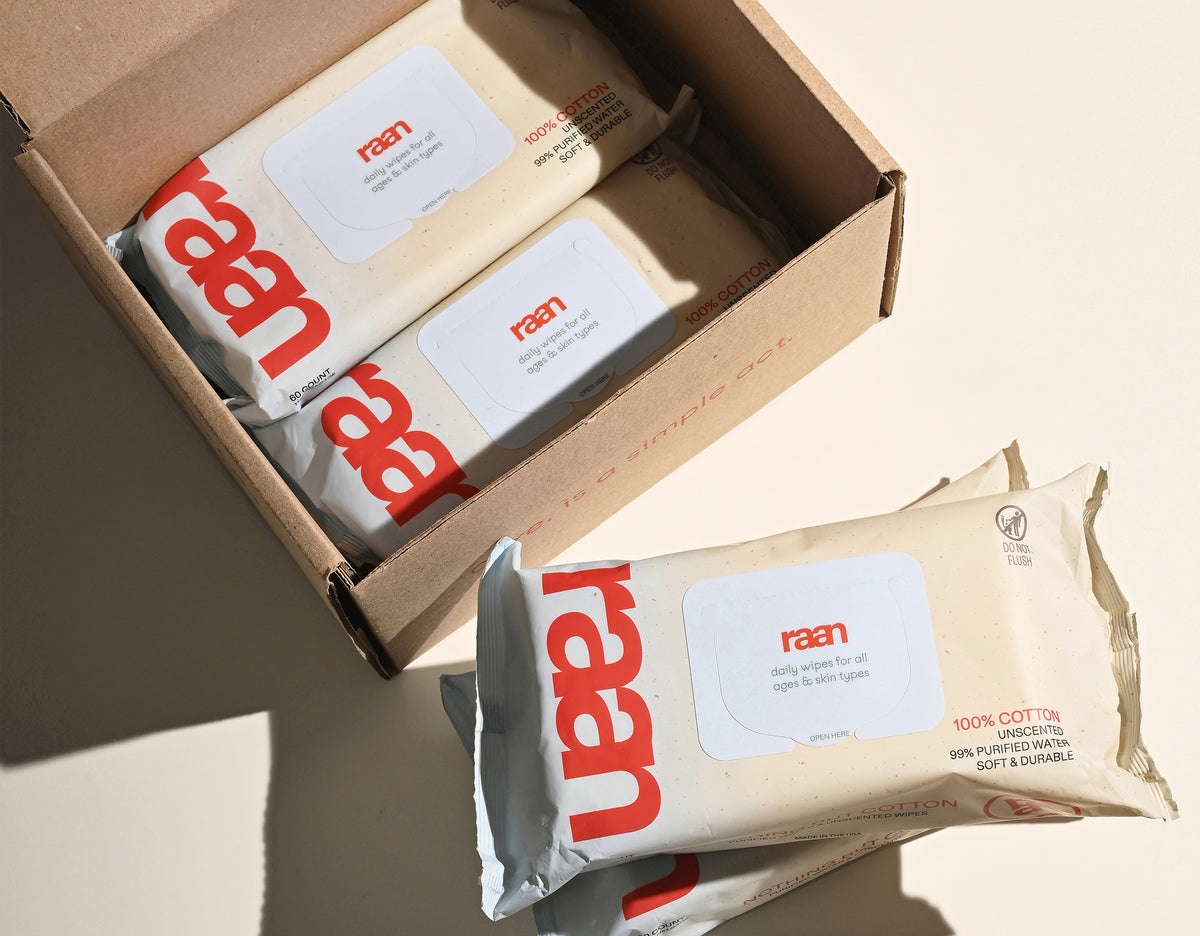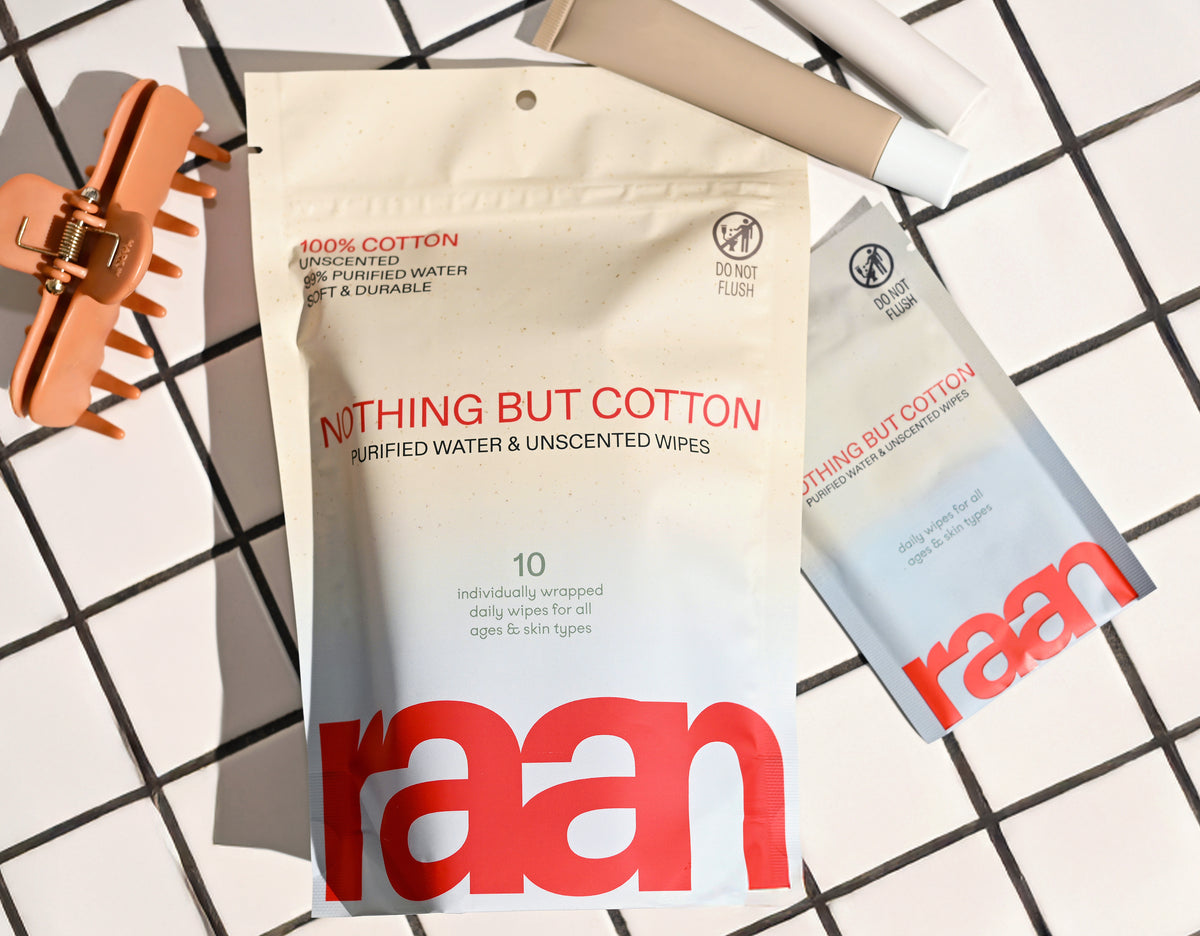Key Takeaways
- Wipes are commonly used for various purposes such as cleaning faces, spills, and hands.
- Many wipes contain hidden plastics and ingredients that are not immediately obvious.
- Marketing claims about wipes often do not reveal the full details of their composition.
- Understanding what wipes are made of can help consumers make more informed choices.
Table of Contents
- What Are Wipes Made Of? The Complete Guide
- The Anatomy of a Wipe: Fabric Meets Formula
- Wipes for Every Purpose: Understanding Different Formulations
- The Hidden Plastic Problem
- Decoding Wipe Ingredient Labels
- How Wipes Are Made: From Fiber to Finished Pack
- The Wipe Ingredient Label Decoded
- Wipes and Sensitive Skin: What to Know
- Biodegradable, Compostable, and Everything In-Between
- Packaging: More Than Meets the Eye
- How to Choose the Right Wipe (And Avoid the Wrong Ones)
- Responsible Wipe Use and Disposal
- Market Shifts: Demand for Truth and Better Materials
- The Raan Standard: What Makes a Wipe Truly Clean
What Are Wipes Made Of? The Complete Guide
You grab a wipe for everything, faces, spills, little hands, skincare touchups. But have you ever paused to ask: what are wipes made of? Behind those convenient packages lies a world of hidden plastics, mystery ingredients, and marketing claims that rarely tell the whole story.
Most conventional wipes contain polyester or polypropylene fibers, essentially plastic, soaked in solutions with synthetic preservatives, fragrances, and additives you can't pronounce. The result? Products that feel soft but leave microplastics on your skin and in landfills for decades.
We'll unpack what really makes up a wipe, decode ingredient labels, and show you how to spot what's truly safe for your skin, your family, and the planet. Because in a world full of "clean" claims, transparency shouldn't be this hard to find.
For more on gentle options, see our guide to soft wipes for newborn skincare.
The Anatomy of a Wipe: Fabric Meets Formula

The Foundation: Understanding Nonwoven Substrates
Every wipe starts with its fabric base, technically called a "nonwoven substrate." Unlike woven cotton towels, these materials are created by bonding fibers together through mechanical, chemical, or thermal processes. The fiber choice determines everything from feel to environmental impact.
Polyester and polypropylene dominate the market. These plastic-based materials are cheap, durable, and water-resistant, but they're also non-biodegradable and shed microplastics with every use. Viscose and rayon offer a silky feel through wood pulp processing, while cotton provides natural absorbency and biodegradability when unbleached.
The manufacturing process matters too. Spunlace technology uses high-pressure water jets to entangle fibers, creating strength without chemical binders. This process works beautifully with 100% cotton, preserving the fiber's natural properties while eliminating synthetic additives.
The Solution: What's in the Wet Part
The liquid formula does the actual cleaning work. Water typically comprises 95-99% of the solution, but it's the remaining ingredients that separate safe from questionable.
Essential components include gentle cleansers to lift dirt, humectants like aloe for skin comfort, and preservatives to prevent bacterial growth. The key question: are these ingredients necessary for function, or added for marketing appeal?
Transparency Test: If a brand won't list every ingredient or explain its purpose, that's your first red flag. True clean means nothing to hide.
Food-grade preservatives like sodium benzoate and potassium sorbate effectively prevent contamination without synthetic additives. Citric acid balances pH to match your skin's natural acidity. When formulated correctly, five ingredients can outperform products with twenty.
Wipes for Every Purpose: Understanding Different Formulations
Baby and Diaper Wipes
Designed for the most sensitive skin, baby wipes should prioritize gentleness over aggressive cleaning power. The best options use 99% water formulas with minimal, recognizable ingredients. However, many brands still rely on plastic substrates and synthetic preservatives.
Look for unscented options with organic aloe and food-grade preservatives. Avoid products with "proprietary blends" or vague "natural fragrance", these terms often hide potential irritants.
Face and Skincare Wipes
Facial wipes need effective cleansing without over-stripping. Many contain micellar water or gentle surfactants for makeup removal, but alcohol-based formulas can disrupt your skin barrier.
The substrate matters enormously here. Plastic fibers can feel harsh against facial skin and don't absorb oils effectively. Unbleached cotton provides superior absorbency and gentleness for daily skincare routines.
For more on facial care, explore our article on face wipes.
The "Flushable" Wipes Reality
Despite marketing claims, most "flushable" wipes contain synthetic fibers that don't break down in water systems. These products clog pipes and burden wastewater treatment facilities. True flushability requires rapid disintegration, something plastic-based wipes simply cannot achieve.
Even plant-based wipes may not be truly flushable depending on your local water system. The safest approach: dispose of all wipes in trash, regardless of packaging claims.
The Hidden Plastic Problem
Why Most Wipes Contain Microplastics
Here's what most brands won't tell you: conventional wipes are essentially plastic sheets soaked in cleaning solution. Polyester and polypropylene fibers shed microscopic particles during use, transferring directly to your skin and eventually to waterways.
These synthetic materials persist in landfills for decades. Even "biodegradable" claims can be misleading, many require specific industrial composting conditions that don't exist in home compost bins.
Plant-Based Alternatives: The Cotton Advantage
Unbleached, 100% cotton offers the ideal combination of performance and environmental responsibility. Cotton fibers naturally biodegrade, contain no synthetic additives, and provide superior absorbency compared to plastic alternatives.
The manufacturing process matters. Unbleached cotton preserves the fiber's natural properties without harsh chemical treatments. When combined with minimal, transparent formulations, cotton-based wipes deliver effective cleaning without compromise.
Decoding Wipe Ingredient Labels

How to Read a Wipe Package
Ingredients appear in descending order by concentration. Water should be first, followed by functional ingredients with clear purposes. Be wary of long lists with chemical names you can't research or verify.
Marketing language often obscures reality. "Pure" and "natural" have no regulatory meaning. "Chemical-free" is scientifically impossible, even water is a chemical. Focus on specific, verifiable claims instead.
Certifications That Actually Matter
EWG Verified certification requires every ingredient to meet strict safety standards with full transparency. The Natural Cotton Seal confirms authentic cotton content without synthetic blends. Cruelty-free certification ensures no animal testing.
These third-party verifications provide accountability that marketing claims cannot. When brands invest in these certifications, it signals a commitment to transparency and consumer trust.
How Wipes Are Made: From Fiber to Finished Pack
Understanding what are wipes made of requires looking beyond the final product to the manufacturing process itself. The journey from raw materials to the wipe in your hand involves precise engineering that directly impacts safety, function, and environmental footprint.
Manufacturing begins with fiber preparation. For conventional wipes, synthetic polyester and polypropylene fibers are blended with binding agents. The spunlace process, also called hydroentangling, uses high-pressure water jets to interlock these fibers without chemical adhesives. This creates the nonwoven substrate that gives wipes their structure and absorbency.
Cotton-based wipes follow a different path. Unbleached cotton fibers undergo carding to align them properly, then spunlace processing creates a naturally soft, highly absorbent substrate without synthetic binding. The absence of bleaching preserves cotton's natural strength while eliminating chemical residues that can irritate sensitive skin.
Solution preparation happens simultaneously. Purified water forms the base, with preservatives, pH balancers, and conditioning agents added in precise ratios. Quality manufacturers test each batch for microbial safety, pH levels, and ingredient stability before application. The substrate then moves through saturation chambers where the solution is evenly distributed, followed by folding machines that create the familiar accordion-style stacking.
For a technical overview of the process, see this industry manufacturing guide.
The Wipe Ingredient Label Decoded
Raan cotton wipes packaging, highlighting ingredient transparency and minimalist formula for gentle skin care." src="https://cdn.shopify.com/s/files/1/0701/7126/3125/t/16/assets/1754620139337-featured-image-raanwebisteproduct01.jpg?v=1754620152" style="width: auto; max-width: 100%; height: auto; max-height: 500px; display: block; margin-left: auto; margin-right: auto;">
Ingredient transparency separates trustworthy wipe brands from those relying on marketing manipulation. Federal regulations require ingredients to be listed in descending order by concentration, but loopholes allow vague terms like "fragrance" to hide dozens of unlisted chemicals.
Start with the substrate material, this information often appears in small print or not at all. If a package doesn't clearly state "100% cotton" or specify the fiber content, assume synthetic materials. Next, examine the solution ingredients. Water should top the list, followed by preservatives and conditioning agents with clear, recognizable names.
Red Flag Terms: "Proprietary blend," "natural fragrance," "plant-based cleansers," or "dermatologist-tested" without specific ingredient disclosure often indicate hidden synthetic components or inadequate transparency standards.
Certifications provide additional verification. EWG Verified means every ingredient has been evaluated for safety and environmental impact. Natural Cotton certification confirms fiber authenticity, while cruelty-free verification ensures ethical testing practices. These third-party validations offer accountability that marketing claims alone cannot provide.
Wipes and Sensitive Skin: What to Know
Sensitive skin requires particular attention to both substrate and solution composition. Synthetic fibers can create micro-abrasions that compromise skin barrier function, while chemical preservatives and fragrances rank among the most common contact allergens. Understanding these triggers helps identify truly gentle options.
The safest approach involves unbleached, 100% cotton substrates saturated with minimal, food-grade ingredients. Cotton's natural softness and absorbency eliminate the need for synthetic conditioning agents, while unbleached processing avoids chlorine residues that can irritate compromised skin. Solution-wise, look for formulations with five or fewer ingredients, all clearly identified and purposeful.
Patch testing remains valuable even with seemingly safe products. Apply a small amount of the wipe solution to inner wrist skin and observe for 24-48 hours. Any redness, itching, or irritation indicates incompatibility. Remember that "hypoallergenic" claims lack regulatory definition, ingredient transparency and third-party testing provide more reliable safety indicators.
For conditions like eczema or dermatitis, consult healthcare providers before introducing new skincare products. They can identify specific ingredient sensitivities and recommend appropriate alternatives that support skin healing rather than exacerbating inflammation.
For further reading, see our recommendations for the best wipes for delicate skin care.
Biodegradable, Compostable, and Everything In-Between

Marketing terms like "biodegradable" and "eco-friendly" sound impressive but lack standardized definitions in the wipes industry. True biodegradability requires specific conditions, time, temperature, and microbial activity, that vary dramatically between landfills and home compost bins.
Compostable wipes must meet stricter standards, breaking down completely within specific timeframes without leaving harmful residues. However, many facilities don't accept personal care items regardless of their compostability claims.
Key Insight: Unbleached 100% cotton wipes naturally compost in appropriate facilities and break down faster than synthetic alternatives, but always verify local disposal guidelines before composting personal care items.
The most honest approach involves choosing materials with proven biodegradability, cotton, bamboo, and wood pulp, while understanding that "eco-friendly" claims require scrutiny and verification.
For a scientific perspective, see this peer-reviewed study on wet wipes and environmental impact.
Packaging: More Than Meets the Eye
Wipe packaging decisions significantly impact environmental footprint and product freshness. Traditional hard plastic lids require substantial material resources and complicate recycling, while soft pouches with resealable closures can reduce plastic usage by up to 70%.
Smart packaging incorporates post-consumer recycled content and eliminates unnecessary components. Boxes made from 100% recyclable materials complete the sustainable package, ensuring every element serves a purpose without excess.
The best packaging preserves wipe moisture and integrity while minimizing environmental impact. This balance requires thoughtful design that prioritizes function over flashy marketing elements.
How to Choose the Right Wipe (And Avoid the Wrong Ones)
Smart wipe selection starts with substrate material, choose 100% plant-based options like unbleached cotton over synthetic blends. Verify this information on packaging, as "cotton-like" often means plastic designed to mimic natural fibers.
Examine ingredient lists for transparency and simplicity. Five to seven components should suffice for effective cleaning and preservation. Each ingredient should serve a clear purpose, water for cleaning, aloe for moisture, food-grade preservatives for safety.
Certifications matter more than marketing claims. EWG Verified ensures ingredient safety, while Cruelty Free and Natural Cotton seals verify ethical and material standards. These third-party validations provide accountability that internal "clean" claims cannot match.
Consider your specific needs: new parents benefit from fragrance-free formulations, while skincare enthusiasts should prioritize gentle, pH-balanced options. Eco-conscious shoppers can focus on packaging innovations that reduce plastic waste without compromising product quality.
For a comprehensive overview, check out our list of the best cotton wipes available today.
Responsible Wipe Use and Disposal

Proper wipe storage prevents drying and contamination. Keep packages sealed when not in use, and store in cool, dry locations away from direct sunlight. Once opened, most wipes maintain optimal moisture for several weeks with proper closure.
Disposal rules are straightforward: never flush wipes unless explicitly labeled as flushable, and even then, consider the strain on local water treatment systems. Most municipal facilities struggle with wipe-related blockages regardless of biodegradability claims.
Compostable cotton wipes may break down in industrial composting facilities, but verify local acceptance policies first. When in doubt, standard trash disposal ensures proper waste management without system disruption.
Market Shifts: Demand for Truth and Better Materials
Consumer awareness drives significant changes in wipe manufacturing and marketing. Shoppers increasingly scrutinize ingredient lists, demand packaging transparency, and reject vague "natural" claims without substance.
Regulatory pressure accelerates this evolution. EU plastics directives target single-use items, while US transparency initiatives push brands toward clearer labeling. These changes benefit consumers by eliminating misleading marketing and improving product honesty.
Awards and recognition increasingly favor brands that prioritize genuine sustainability over greenwashing. Recent industry recognition for innovative materials and transparent practices signals a market shift toward accountability and authentic environmental responsibility.
The Raan Standard: What Makes a Wipe Truly Clean
Raan wipes are built on a simple promise: real transparency, real safety, and real function. We use unbleached, 100% cotton as our foundation, no plastic fibers, no synthetic blends. Our formula is minimalist by design: purified water, food-grade sodium benzoate and potassium sorbate for preservation, ethylhexylglycerin for skin conditioning, organic aloe for moisture, and citric acid for pH balance. That’s it, just five EWG-verified ingredients, each with a clear purpose.
Our wipes are EWG Verified, Cruelty Free, and carry the Natural Cotton Seal. We’re proud to be Women Owned and made in the USA. Our packaging uses 70% less plastic than standard wipes by skipping the hard plastic lid, and our pouch contains 35% post-consumer waste. Even our boxes are 100% recyclable.
We believe clean should be uncomplicated. No greenwashing, no vague claims, just honest materials and full ingredient transparency. Whether you’re a new parent, a skincare lover, or anyone who wants better for their home and skin, Raan wipes are made for real, everyday messes. Because you deserve care that’s as honest as it is effective.
Frequently Asked Questions
What materials are commonly used to make wipes, and how do they impact the environment?
Most wipes are made from either synthetic plastic fibers like polyester or polypropylene, or natural fibers such as cotton or viscose. Plastic-based fibers don’t biodegrade easily and contribute to microplastic pollution, while natural fibers like unbleached cotton break down more readily and have a smaller environmental footprint. Choosing wipes made from minimally processed, earth-derived materials helps reduce plastic waste and supports a cleaner planet.
How can consumers decode wipe ingredient labels to identify potentially harmful additives?
Look for clear, specific ingredient names rather than vague terms like ‘fragrance’ or ‘natural extracts,’ which can hide irritants or allergens. Avoid synthetic preservatives that aren’t food-grade, dyes, bleach, and plastic microfibers. Focus on ingredients verified by trusted sources, such as EWG, and prioritize formulas with minimal, well-understood components like purified water, food-grade preservatives, and plant-based moisturizers.
What are the differences between plastic-based fibers and natural fibers in wipes?
Plastic-based fibers are synthetic, often made from petroleum, and can shed microplastics that persist in the environment. Natural fibers, like unbleached cotton, come from renewable plant sources and decompose naturally without leaving harmful residues. Natural fibers also tend to be gentler on skin since they don’t carry synthetic residues or chemicals used in plastic fiber production.
Why is transparency about wipe ingredients important, and how can I choose safer wipes for sensitive skin?
Transparency lets you understand exactly what you’re putting on your skin and into your home, helping avoid hidden irritants or misleading claims. For sensitive skin, choose wipes with a short, straightforward ingredient list featuring only EWG-verified, food-grade preservatives and soothing botanicals like organic aloe. Opt for wipes made from unbleached, 100 % cotton to minimize exposure to synthetic fibers and harsh chemicals.






